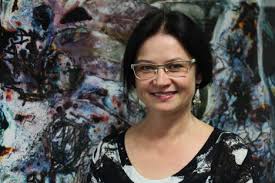Griffith photography alumnus Dr Renata Buziak was commissioned to create a stunning artwork that weaves its way across three levels of the new Engineering, Technology and Aviation Building (N79) at Nathan campus.
The six level building opened to students at the start of the year and Dr Buziak’s artwork has succeeded in bringing the outside indoors like never before.
Dr Buziak has pioneered a new process that she calls ‘bio-chrome’, created by decomposing native flora on photographic plate.
Her photographs of medicinal native plants from Minjerribah/North Stradbroke Island were transferred onto large glass panels around N79, creating an eye-catching immersive artwork.
Art meets science
 “I think of my work as a collaboration with the natural world,” she said.
“I think of my work as a collaboration with the natural world,” she said.
“I’ve always loved experimenting and had an interest in science. During my undergraduate studies at Griffith I started playing around with natural materials and decay.
“I work mainly outdoors and let the microbes and bacteria do their work.
“My work embraces the cycle of life, which we are a part of, and the process of decay and renewal.
“In this case the work focuses on significant healing plants from Minjerribah, where I had the privilege of working with members of the Quandamooka community during my PhD practice-led research.
‘I’m amazed and humbled’
Dr Buziak’s work creates a unique visual identity for the 6000m2 energy efficient and low carbon building, which took three years from concept to final construction and includes specialised laboratories, workshops, informal learning spaces, engagement spaces, a simulation studio and a rooftop garden.
The talented artist said taking on a large-scale commission was a new challenge.
“My project grew as the building did, it was very exciting to see the project in progress and plan the design with architectural drawings, and imagining where the walls of glass panels will be located,” she said.
“It has been so rewarding – I’m amazed and very humbled to have my work selected for the new building, it’s absolutely thrilling to see.
“It’s not until you go inside and grasp the scale, you see how it all fits together with the astonishing architectural design. I was overwhelmed.”
Works from the series will be exhibited at the Head On Photo Festival in a solo outdoor exhibition at the Sydney Royal Botanic Gardens in May.
Learn more about N79 and why its being called a Living Laboratory.

